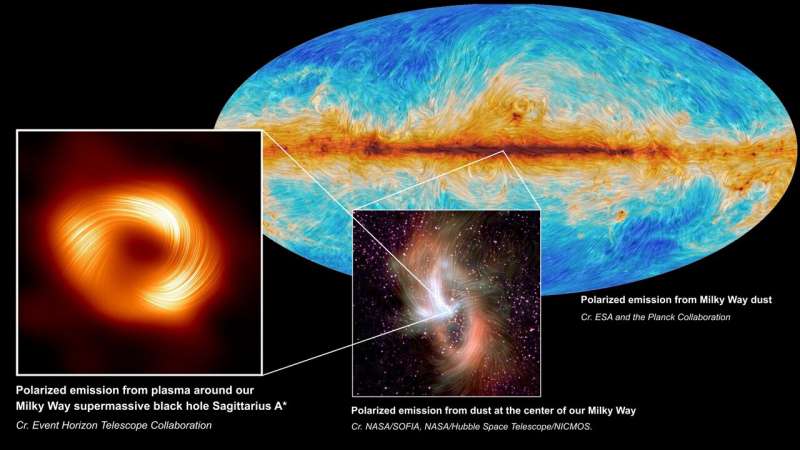Scientists have captured a new image of the supermassive black hole at the center of our galaxy, Sagittarius A* (Sgr A*), using polarized light for the first time. This image reveals strong and organized magnetic fields spiralling around the black hole, similar to what was observed around the black hole M87* in 2019.
This suggests that all black holes must have a powerful magnetic field
The discovery, made by the Event Horizon Telescope (EHT) collaboration, suggests that powerful magnetic fields might be a common feature of all black holes. The image also hints at the presence of a hidden jet emanating from Sgr A*, similar to the powerful jet observed near M87*.
Previously, scientists had captured the first image of Sgr A* in regular light, revealing its general shape and size. However, studying the black hole in polarized light offers a deeper understanding of its surrounding magnetic fields. Light waves vibrate in a specific direction, and when they become polarized, this vibration is restricted to a single plane.

By analyzing the pattern of polarization in the light coming from around Sgr A*, scientists can map the structure and strength of the black hole’s magnetic field lines. These fields play a crucial role in how black holes interact with surrounding gas and matter. They can help fuel the growth of black holes by funneling material inwards and may also be responsible for launching powerful jets of particles outward.
Capturing a polarized image of Sgr A* was a significant challenge because the black hole is much more dynamic than M87*. M87* is a steadier target, allowing for longer observation periods to create a clear image. Sgr A*, on the other hand, changes rapidly, requiring more sophisticated research techniques and data analysis.
Despite the challenges, scientists are excited about the new findings. The similarities between the magnetic fields of Sgr A* and M87* suggest that black holes, regardless of size or mass, might share some fundamental properties. This discovery opens doors to a deeper understanding of how black holes operate and their role in the universe.
The EHT collaboration is continuously improving its technology and plans to observe Sgr A* again in April 2024. These ongoing observations, coupled with advancements in telescopes and data analysis, promise to reveal even more secrets about black holes in the future. The ultimate goal is to capture high-fidelity movies of Sgr A*, potentially revealing the hidden jet and providing a more detailed view of its dynamics. Additionally, future space-based telescopes like the Black Hole Explorer (BHEX) could deliver even sharper images, allowing scientists to study the properties of black holes across space in high detail.
RELATED:
- This Company is offering a Michelin-star Meal in Space for Just $500 Million
- Chinese Scientists Create a Brain-Analysis Chip by Learning from Space Research
- Get latest Oneplus 12 Phone for $699 on Geekwills
- Get $100 OFF on Xiaomi 14 Pro at Giztop (1TB Variant)
- Best of MWC 2024: AI Phone, Transparent Laptop, 3D Tablet & More
(Via)




